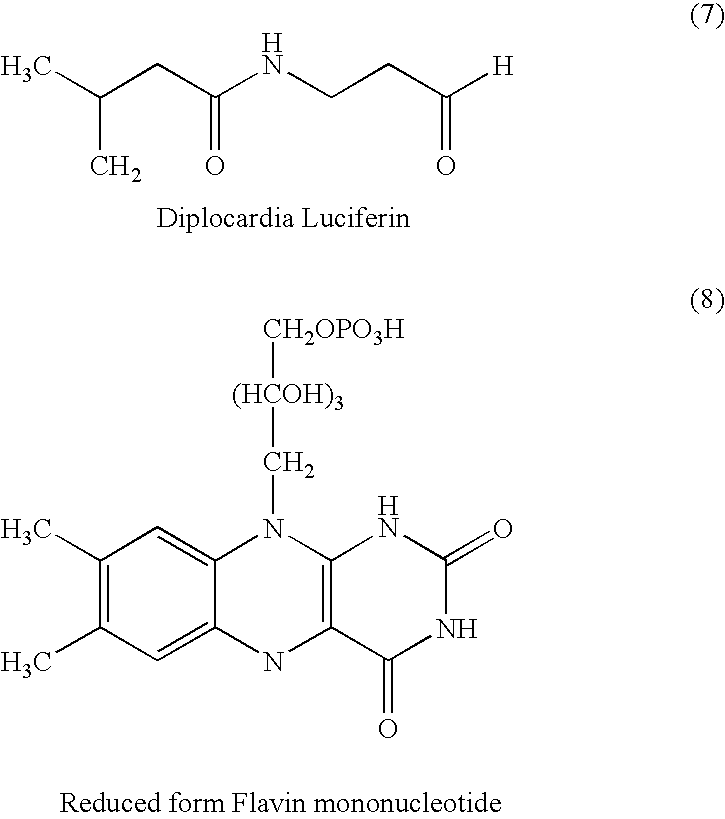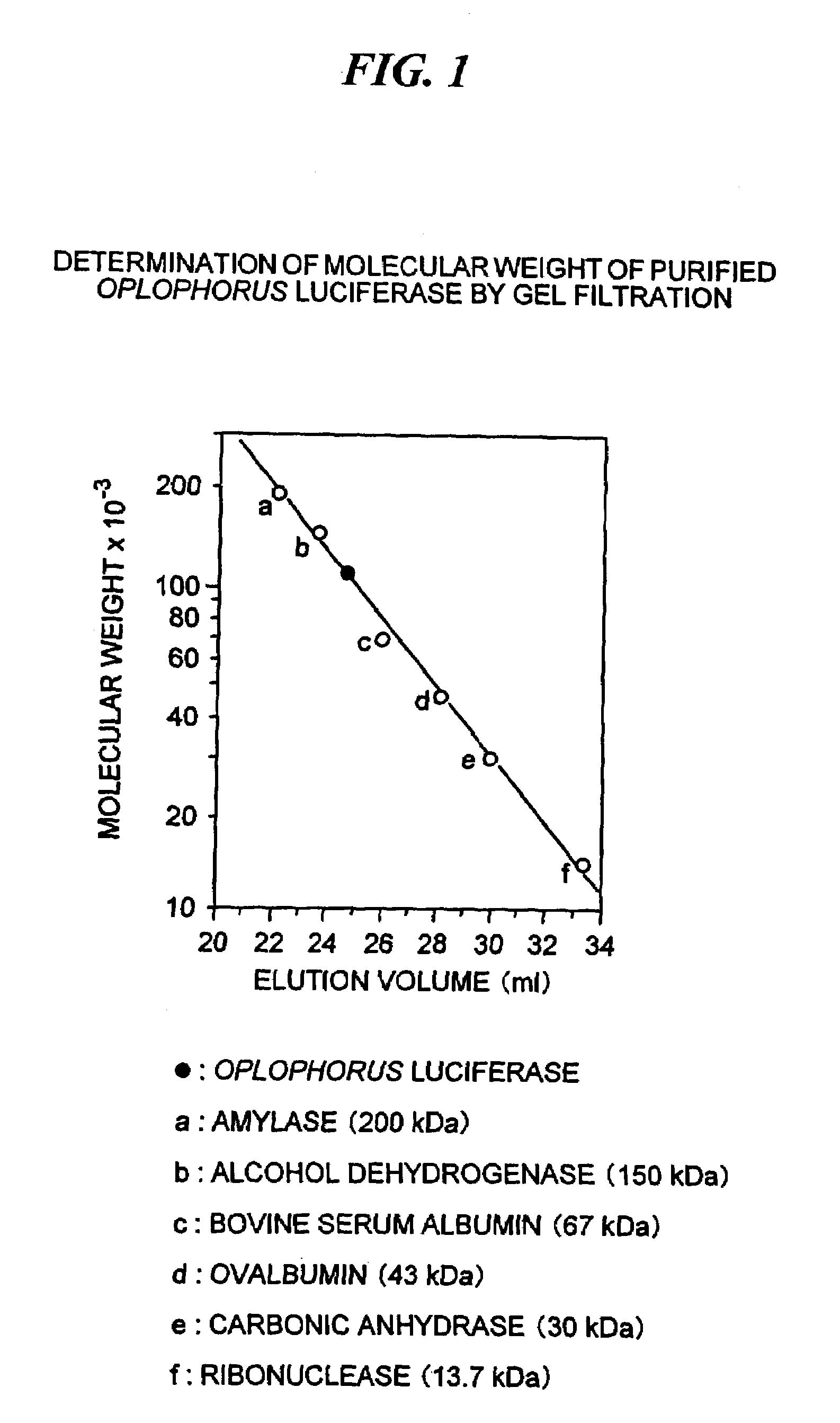Luciferase and photoprotein
a luciferase and photoprotein technology, applied in the field of luciferase and photoprotein, can solve the problems of low yield, no enzyme applicable to extensive purposes, and low yield
- Summary
- Abstract
- Description
- Claims
- Application Information
AI Technical Summary
Problems solved by technology
Method used
Image
Examples
example 1
Purification and Identification of the Protein Components of Oplophorus Luciferase
[0075]The deep-sea luminous shrimp (Oplophorus gracilirostris) obtained in the Suruga Bay, Shizuoka, Japan were used as a starting material. A crude extract containing Oplophorus luciferase was prepared in the same manner as disclosed by Shimomura, et al., in Biochemistry 17 (1978) and further purified by chromatography in two steps. The first step was by hydrophobic interaction chromatography on a column of butyl Sepharose 4 Fast Flow (Pharmacia; 0.7 cm×3.5 cm) using 20 mM Tris-HCl, pH 8.5, eluting with decreasing concentrations of ammonium sulfate starting at 1.5 M. The second step was by gel filtration on a column of Superdex 200 Prep (Pharmacia; 1 cm×48 cm) in 20 mM Tris-HCl, pH 8.5, containing 50 mM NaCl. The molecular weight of Oplophorus luciferase was estimated to be about 106 kDa by gel filtration on the same column when compared with the molecular weight markers as follows: (a) amylase (200 k...
example 2
Determination of an Amino Acid Sequence of Oplophorus Luciferase
[0077]The amino acid sequence analysis was carried out using Applied Biosystems model 470A gas phase sequencer according to protocols of the manufacturer. Sample proteins for the sequence analysis were prepared as described below.
[0078](1) The two protein bands of the purified luciferase, the 35 kDa and 19 kDa, separated by SDS-PAGE using 12% polyaclylamide gel were transferred electrophoretically onto a polyvinylidene difuoride membrane (Millipore, Bedford, Mass., USA) at 150 mA for 1 hour. The membranes were then stained and the two bands of the 35 kDa and 19 kDa were subjected to sequence analysis to determine their partial amino acid sequences.
[0079](2) The 35 kDa protein was obtained from the native luciferase (50 μg) by reversed phase HPLC on a 5C4 column (Waters; 0.39 cm×15 cm) by gradient elution with increasing concentrations of acetonitrile (0–80% in 80 min; solvent: acetonitrile / water / 0.1% trifuoroacetic acid...
example 3
Construction of Oplophorus cDNA Library and Cloning of a Gene Encoding Oplophorus Luciferase
[0085]Live specimens of O. gracilirostris obtained in the Suruga Bay were frozen on dry ice and stored at −80° C. until used. Total RNA was prepared by the guanidine isothiocyanate method (see, e.g. Inouye, S. & Tsuji, F. I., FEBS Lett., 315 (1993), pp. 242–246), followed by precipitation with 2M LiCl. The yield of total RNA from two whole specimens (body size: 40 mm length, 2.8 g wet-weight) was approximately 0.9 mg. Then, poly(A)+ RNA (2 μg) was isolated by oligo(dT)-cellulose spun-column (Pharmacia, Piscataway, N.J., USA) and subjected to the synthesis of cDNA with dT12-18 primers using a cDNA synthesis kit (Time saver cDNA synthesis kit; Pharmacia) according to Kakizuka, et al. (Essential Developmental Biology, Stern, C. D. ed., IRL Press, Oxford, U.K., pp. 223–232 (1993)). The synthesized cDNAs (20 ng) were ligated with EcoRI / NotI linker. Then, cDNAs were ligated with 1 μg of EcoRI diges...
PUM
| Property | Measurement | Unit |
|---|---|---|
| molecular mass | aaaaa | aaaaa |
| molecular mass | aaaaa | aaaaa |
| molecular weight | aaaaa | aaaaa |
Abstract
Description
Claims
Application Information
 Login to View More
Login to View More - R&D
- Intellectual Property
- Life Sciences
- Materials
- Tech Scout
- Unparalleled Data Quality
- Higher Quality Content
- 60% Fewer Hallucinations
Browse by: Latest US Patents, China's latest patents, Technical Efficacy Thesaurus, Application Domain, Technology Topic, Popular Technical Reports.
© 2025 PatSnap. All rights reserved.Legal|Privacy policy|Modern Slavery Act Transparency Statement|Sitemap|About US| Contact US: help@patsnap.com



